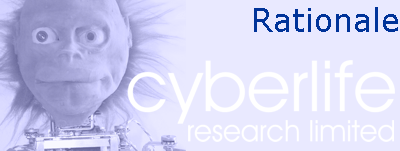
|
|
|
Why build a robot? Why such a complicated one? Why try to tackle all the problems at one go? This is not strictly a scientific (analytical) project but an engineering one. Instead of trying to understand the brain by taking one apart, we are trying to understand one by putting it together. By facing up to the same challenges that nature faces, while keeping a close eye on what we know about how she has solved it, we can hope to see underlying principles that are completely opaque to us when we look at the structure of real brains without any idea of what made them be this way. Lucy is therefore intended to: Be a complete organism with a fairly complete brainTo see the unity underlying the diversityThe brain does many things, but large parts of it look extremely similar, at least initially. This shows that at some level of description all the things the brain does are actually the same thing. The only way to discover this unifying level of description is to look at a wide range of brain functions and look for the common features. Because learning involves correlationWe see depth partly because we have arms that can reach out and touch things, allowing our brains to correlate what we see with what we feel. Equally, we can reach out and touch things because we have eyes that can see depth. Much learning involves multimodal interaction like this - a pair of eyes alone is not sufficient to allow a mind to develop. Because we were amphibians onceThe mammalian brain is really several brains sitting on top of one another. Modern parts evolved to add new features to the earlier fully working system. Only by building examples of systems at all these levels will we understand what the 'higher' brain is doing. Because Mr. Spock was incompetentSpock was supposed to be intelligent without emotion. Nonsense! Emotion is a crucial factor in learning - it tells us how we feel about what's happening to us. Without emotion we can't learn. Lucy therefore needs more than just vision and reasoning power. Be embodied and situated(in other words a real robot in a real, complex environment) Because words have meaningsMany attempts at AI fall foul of the 'symbol grounding problem'. You can only understand and reason at a symbolic level if those symbols really mean something. Pain has to hurt, pleasure has to correlate with benefit. Try describing what "hot" means to a robot that can't feel heat. Because some intelligence is really physicsThe control systems of our brains and the physical properties of our limbs, our sensors and the world around us combine together to create intelligent action. Leaving out the physics breaks that critical loop. Have Biologically realistic systemsBecause nature works that way for a reasonThe task is to understand something fundamental about the brain. Brains don't talk in ASCII code - they talk in muscle tensions and retinal signals. Our senses have co-evolved with our brains, so that each depends on the other. Trying to understand or even replicate the functions of the brain using video cameras and electric motors is futile. It is important to modify these technologies to make them appear as similar as possible to their biological equivalents. Be a babyBecause you need to drop things before you can discover the laws of gravityEarly attempts at AI tried to build fully-formed adult reasoning machines. But for animals babyhood is an essential step on the road to adult knowledge. So why not robots? How can any system have high-level concepts without low-level ones to build them upon? Be a structural model not information processingBecause elephants are not barrels with snakes strapped to the frontIn other words, analogies are not reversible. Chess is like a war, but you can't fight a real battle using chess moves. An elephant might look like a barrel with a snake strapped to the front, but attaching a snake to a barrel does not make an elephant. An awful lot of AI fails to see this and tries to solve the problem by saying "we can make a machine see objects like this, and move its arms using this other method, and speak using this algorithm. Intelligent creatures do all these things, so if we put all these things together we will have made an intelligent creature". This is complete nonsense. Think about it. Be top-down as well as bottom-upBecause reactive brains are too slowThe primary imperative of a brain is to compensate for signal delays. It's no good waiting until your leg is in the desired position before trying to stop it moving - it'll overshoot. Reactive systems are therefore completely unlike intelligent systems (if we discount very simple or very slow creatures). The production of predictive models is a crucial component of the mammalian brain's function, and requires top-down connections. Because brains are not sausage machinesRead my book for more on this. Suffice it to say that the wiring doesn't fit - the brain is definitely a bidirectional machine, and motor outputs do NOT arise from the opposite end of the chain from sensory inputs. Because the tension produces the structureA major element of my theories rests on this bidirectional structure and the balance of tension generated in it. This is how I think the brain discovers how to wire itself up. Genes have very little to do with it. |
Copyright © 2004 Cyberlife Research Ltd. |